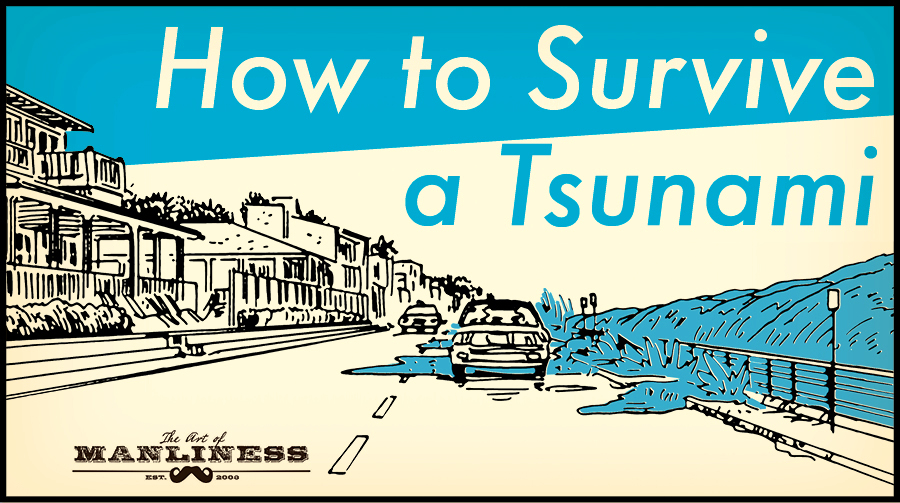How to Survive a Tsunami

Tsunamis are capable of causing devastating damage. In 2004, when a massive earthquake struck off the coast of Sumatra, the resulting tsunamis killed an estimated 230,000 people spread across 14 countries, including Kenya, over 4,000 miles away.
Despite what you may have seen in cartoons or the latest doomsday blockbuster, tsunamis don’t look like giant versions of the type of curling waves that surfers crave. Instead, tsunamis more closely resemble flash floods. When tsunami waters hit the beach, they may only be as high as 10 feet. But as that water continues to surge inland, it can grow to a height of up to 100 feet and travel for miles. This fast-moving wall of water wreaks havoc on everything in its path, breaking windows, uprooting trees, and snapping power poles. The resulting soup of debris is likely to kill anyone who is pulled in. Surviving them requires a combination of good preparation, quick thinking, and decisive action.
Be Prepared
One of the best ways to be prepared for a tsunami is to put together a simple bag of essential emergency supplies. A flashlight, warm clothes or blanket, battery pack for charging your cell phone, water, and food are all great items to put in your bag. You can also purchase an NOAA Weather Radio to stay informed about emergency services and get notifications about when it’s safe to return to areas affected by the tsunami. Keep your bag near the door, and perhaps an extra in your car, so that you can grab it wherever you are and get to safety with your necessary gear quickly.
Being prepared also means having a plan with friends and family about how to reunite if a tsunami strikes when you’re separated. Discuss meeting points and communication strategies, and work together to make sure everyone understands proper survival techniques.
Recognize the Warning Signs
If you live within a few miles of the coast and feel an earthquake, assume that a tsunami will follow and begin your evacuation plan.
However, you may not feel the earthquake that triggers a tsunami that can still affect you; tsunamis can damage coastlines thousands of miles away from the shaking that caused them. Tsunamis are also not only caused by earthquakes, but can be triggered by a large landslide or meteor impact.
You may receive an official alert via television, text, or radio that a tsunami is imminent, but don’t absolutely count on that; tsunamis can move in deep water at 600 miles an hour and strike before an alert has been issued.
In the absence of a tremor or an alert, keep a lookout for a natural sign that a tsunami is coming: the ocean tide has receded farther and more rapidly than usual. When offshore earthquakes occur, the displacement caused by the movement of the earth pulls water away from coastlines. As the earth settles, that water rushes back towards shore, creating a tsunami. If you’re near the beach and seeing portions of the seafloor you’ve never seen before, get moving.
Get Away From Water
The best thing to do in the event of an oncoming tsunami is to get away from the coast, as well as rivers and estuaries near the coast that will flood quickly. Experts say that it’s best to try and get at least 100 feet above sea level or two miles away from the coast. Whether you go up or away depends on your situation. Those living in remote, rural areas may be able to hop in their car and drive quickly away from the water. Urban dwellers are less likely to be able to drive, especially after an earthquake which will likely cause damage to roads and bridges.
If you can’t get away, go up. Whether it’s the rooftop of a nearby building or the biggest hill in a nearby park, getting high is your best option if you can’t get further inland.
In the event a tsunami strikes and you’re caught directly in its path, know that it can move faster than you can run, and try to grab and hold on to a large piece of debris. People have survived the rush of water by climbing onto the roofs of houses that were torn off their foundations. By using larger debris, you can protect yourself from getting pulled down into the water and knocked around by smaller pieces of debris.
Stay Vigilant and Be Patient
Much like the way that aftershocks follow earthquakes, tsunamis are rarely reduced to a single occurrence. In fact, the first surge isn’t the highest, and larger second and third waves of tsunamis are capable of striking the shoreline over several hours. Your best bet, once you reach a safe area, is to stay put until you can confirm that the threat of danger is over.
- Get link
- X
- Other Apps
Labels
Classic Car
Labels:
Classic Car
- Get link
- X
- Other Apps
Comments
Post a Comment